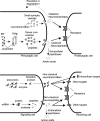Hemopressin and other bioactive peptides from cytosolic proteins: are these non-classical neuropeptides?
- PMID: 20383670
- PMCID: PMC2895439
- DOI: 10.1208/s12248-010-9186-0
Hemopressin and other bioactive peptides from cytosolic proteins: are these non-classical neuropeptides?
Abstract
Peptides perform many roles in cell-cell signaling; examples include neuropeptides, hormones, and growth factors. Although the vast majority of known neuropeptides are produced in the secretory pathway, a number of bioactive peptides are derived from cytosolic proteins. For example, the hemopressins are a family of peptides derived from alpha and beta hemoglobin which bind to the CB1 cannabinoid receptor, functioning as agonists or antagonists/inverse agonists depending on the size of the peptide. However, the finding that peptides derived from cytosolic proteins can affect receptors does not prove that these peptides are true endogenous signaling molecules. In order for the hemopressins and other peptides derived from cytosolic proteins to be considered neuropeptide-like signaling molecules, they must be synthesized in brain, they must be secreted in levels sufficient to produce effects, and either their synthesis or secretion should be regulated. If these criteria are met, we propose the name "non-classical neuropeptide" for this category of cytosolic bioactive peptide. This would be analogous to the non-classical neurotransmitters, such as nitric oxide and anandamide, which are not stored in secretory vesicles and released upon stimulation but are synthesized upon stimulation and constitutively released. We review some examples of cytosolic peptides from various protein precursors, describe potential mechanisms of their biosynthesis and secretion, and discuss the possibility that these peptides are signaling molecules in the brain, focusing on the criteria that these peptides would have to fill in order to be considered non-classical neuropeptides.
Figures


Similar articles
-
Analysis of mouse brain peptides using mass spectrometry-based peptidomics: implications for novel functions ranging from non-classical neuropeptides to microproteins.Mol Biosyst. 2010 Aug;6(8):1355-65. doi: 10.1039/c003317k. Epub 2010 Apr 28. Mol Biosyst. 2010. PMID: 20428524 Free PMC article. Review.
-
Hemoglobin-derived peptides as novel type of bioactive signaling molecules.AAPS J. 2010 Dec;12(4):658-69. doi: 10.1208/s12248-010-9217-x. Epub 2010 Sep 2. AAPS J. 2010. PMID: 20811967 Free PMC article. Review.
-
Analysis of peptides secreted from cultured mouse brain tissue.Biochim Biophys Acta. 2013 Nov;1834(11):2408-17. doi: 10.1016/j.bbapap.2013.01.043. Epub 2013 Feb 10. Biochim Biophys Acta. 2013. PMID: 23402728 Free PMC article.
-
Characterization of pepcan-23 as pro-peptide of RVD-hemopressin (pepcan-12) and stability of hemopressins in mice.Adv Biol Regul. 2021 May;80:100808. doi: 10.1016/j.jbior.2021.100808. Epub 2021 Mar 24. Adv Biol Regul. 2021. PMID: 33799079
-
Neuropeptides: metabolism to bioactive fragments and the pharmacology of their receptors.Med Res Rev. 2015 May;35(3):464-519. doi: 10.1002/med.21323. Epub 2014 Jun 3. Med Res Rev. 2015. PMID: 24894913 Review.
Cited by
-
Disease-specific heteromerization of G-protein-coupled receptors that target drugs of abuse.Prog Mol Biol Transl Sci. 2013;117:207-65. doi: 10.1016/B978-0-12-386931-9.00009-X. Prog Mol Biol Transl Sci. 2013. PMID: 23663971 Free PMC article. Review.
-
Current Challenges and Future Directions in Peptidomics.Methods Mol Biol. 2024;2758:485-498. doi: 10.1007/978-1-0716-3646-6_26. Methods Mol Biol. 2024. PMID: 38549031
-
Quantitative peptidomics for discovery of circadian-related peptides from the rat suprachiasmatic nucleus.J Proteome Res. 2013 Feb 1;12(2):585-93. doi: 10.1021/pr300605p. Epub 2013 Jan 11. J Proteome Res. 2013. PMID: 23256577 Free PMC article.
-
Hemoglobin α-derived peptides VD-hemopressin (α) and RVD-hemopressin (α) are involved in electroacupuncture inhibition of chronic pain.Front Pharmacol. 2024 Oct 1;15:1439448. doi: 10.3389/fphar.2024.1439448. eCollection 2024. Front Pharmacol. 2024. PMID: 39411061 Free PMC article.
-
Mass Spectrometry-based Proteomics and Peptidomics for Systems Biology and Biomarker Discovery.Front Biol (Beijing). 2012 Aug 1;7(4):313-335. doi: 10.1007/s11515-012-1218-y. Front Biol (Beijing). 2012. PMID: 24504115 Free PMC article.
References
-
- Schwartz JH. Neurotransmitters. In: Kandel ER, Schwartz JH, Jessell TM, editors. Principles of Neural Science. 4. New York: McGraw-Hill; 2000. pp. 280–297.
-
- Eipper BA, Mains RE, Herbert E. Peptides in the nervous system. Trends Neurosci. 1986;9:463–468. doi: 10.1016/0166-2236(86)90149-9. - DOI
Publication types
MeSH terms
Substances
Grants and funding
LinkOut - more resources
Full Text Sources
Miscellaneous

